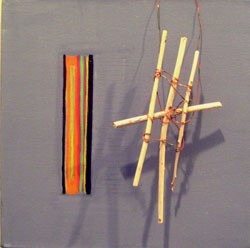
- “Lines and Sticks” by Linda Maney
Swiss artist Paul Klee famously said, “A line is a dot that went for a walk.” In Studio Place Arts’ current group exhibit, titled “Line It Up,” 18 artists from around Vermont interpret the meaning of line as an aesthetic concept. The 30 works, including drawing, sculpture, painting and printmaking, suggest that line isn’t as pedestrian as Klee’s quote might suggest.
Dimensionality doesn’t immediately come to mind when considering line, but several works in the show break the two-dimensional mold. “Lines and Sticks” by Linda Maney is a 12-by-12-inch wall piece presenting a range of lines in 2-D and 3-D. To the left is a vertical band of acrylic orange, turquoise and purple painted lines; to the right are four sticks held together with copper wire. If you consider the shadows in the composition, there are four kinds of line.
Another sculptural work is the assemblage “Bird Song” by Dorothy C. Weicker. The 48-by-14-inch vertical composition incorporates burlap, cassette tape, shredded batik, feathers and colorful threads affixed to a metal screen. It’s an iconographic object, like an abstract mask or other ritual item. Its lines in themselves do not make a subject but — like texture or color — simply help to define the object.
David Powell’s 10-by-14-inch collage “Mining for Disaster” appropriates 19th-century technical images and diagrams to create an absurdist, fine-lined narrative, such as might be found in a dictionary or encyclopedia. His “A Fine Balance, A Juggling Lesson” uses 20th-century pictures in the same way. Its paper has a yellow cast, except for the figure of a boy in white. The contrast between the two creates a line in negative space.
“Landscape #144” is a 22-by-28-inch ink drawing by Karolina Kawiaka of White River Junction. She produced a matrix of small squares that seem like overlapped pieces of screen. The drawing also reads like abstract cartography, with areas around the squares left completely blank. The similarly scaled, more elaborate “Landscape #123” in colored pencil is dark and layered in tiny squares of whites, grays, reds, blues and greens.
Springfield, Vt., artist Robert Carsten also fills his paper with small forms, but “Keys to Value” is based in realism. His 28-by-18-inch drawing executed in marker depicts hundreds of hanging keys, alive with varied rhythms and diagonal strokes. In the art-jargon sense of the word “value,” the drawing exhibits differing gradations of dark and light.
Marie LaPré Grabon’s 10-by-14-inch charcoal “Reclining Nude w/Reflection” is a Matissian odalisque, and one of the few figurative pieces in the show. LaPré Grabon skillfully varied the weights of her lines and contrasted the lines of her figure with background patterning. She also smudged charcoal dust to introduce grays to the image.
The most minimal works in the show are “Springtime” by Mark Heitzman and “Beach Grass #39” by Pria Cambio. Both consist of simply a few lines in space. Heitzman’s graphite work on paper is a group of loops and circles trailing down the picture plane at a slight angle, while Cambio used ink in a calligraphic manner, creating a few quickly drawn grasses.
Line has many guises and uses in art, from the decorative to the structural, and “Line It Up” demonstrates just how varied it can be.









Comments
Comments are closed.
From 2014-2020, Seven Days allowed readers to comment on all stories posted on our website. While we've appreciated the suggestions and insights, right now Seven Days is prioritizing our core mission — producing high-quality, responsible local journalism — over moderating online debates between readers.
To criticize, correct or praise our reporting, please send us a letter to the editor or send us a tip. We’ll check it out and report the results.
Online comments may return when we have better tech tools for managing them. Thanks for reading.